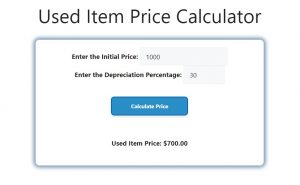About Used Item Price Calculator (Formula)
When buying or selling used items, determining the right price is essential to ensure a fair transaction for both parties. The Used Item Price Calculator helps you find the value of a used item by factoring in depreciation over time. This guide will explain the formula, how to use it, give an example, and answer common questions related to pricing used items.
Formula
The formula to calculate the used item price is:
Used Price (UP) = Initial Price (IP) − Initial Price (IP) × Depreciation Rate (D) / 100
Where:
- UP = Used Price (the final value of the used item)
- IP = Initial Price (the original price of the item when new)
- D = Depreciation Rate (the percentage by which the item loses value over time)
How to Use
- Determine the Initial Price (IP): Identify the original price of the item when it was new.
- Estimate the Depreciation Rate (D): Decide how much value the item has lost over time, based on its condition, usage, and age.
- Apply the Formula: Subtract the depreciation value from the initial price to get the used price.
- Use the Calculator: Enter the initial price and depreciation rate into the Used Item Price Calculator for a quick result.
Example
Let’s assume you want to sell a laptop that originally cost $1,000. The depreciation rate, considering its age and condition, is 30%. Using the formula:
UP = 1,000 − 1,000 × 30 / 100
UP = 1,000 − 300
UP = $700
The used price of the laptop is $700.

FAQs
- What is depreciation?
Depreciation refers to the loss in value of an item over time due to factors like wear and tear, age, or newer models being available. - How do I estimate depreciation for a used item?
Depreciation depends on the type of item, how old it is, its condition, and the market demand for it. Common rates range from 10% to 50% or more, depending on the item. - Can I use this formula for any type of item?
Yes, the formula works for electronics, furniture, vehicles, appliances, and more. - What is the average depreciation rate for electronics?
Electronics typically lose 20-30% of their value in the first year and can lose more depending on how long they have been used. - How does the condition of an item affect depreciation?
Items in excellent condition depreciate less than those with visible damage, missing parts, or heavy wear. - Can I adjust the depreciation rate for different types of items?
Yes, the depreciation rate can be customized based on the item’s category (e.g., electronics, furniture, clothing). - How do I calculate the used price if I don’t know the initial price?
Research the item’s original price online or use a similar model to estimate the initial price. - Is the depreciation rate the same for all items?
No, some items depreciate faster than others. For example, cars and electronics tend to depreciate faster than furniture or appliances. - Does market demand affect the used price?
Yes, if an item is in high demand, its used price may be higher even if it’s older, while items with low demand may depreciate more. - Can I use the calculator for vehicles?
Yes, the calculator works for vehicles, but cars typically have their own specific depreciation rates based on mileage, age, and condition. - How accurate is this formula for determining used prices?
While the formula gives a good estimate, actual used prices can fluctuate based on market conditions and buyer demand. - Does the brand of an item affect depreciation?
Yes, high-end brands often retain their value longer and depreciate at a slower rate compared to lesser-known or budget brands. - How do I price an item if it’s no longer available for purchase?
Research similar items on second-hand marketplaces or use historical prices as a reference to estimate the original price. - How do I calculate the depreciation rate for clothing?
Clothing typically depreciates based on wear and trends, with an average rate of 20-50%, depending on the brand and condition. - Can I use the calculator for luxury items like jewelry?
Yes, the formula works for luxury goods, though some high-end items may appreciate rather than depreciate. - What’s the typical depreciation rate for furniture?
Furniture generally depreciates at 15-30% annually, depending on its condition and the material quality. - How can I calculate the used price for vintage or antique items?
Vintage and antique items may not depreciate and can even increase in value over time. For these, the calculator can be used with a lower or zero depreciation rate. - Can I use this formula for real estate?
While this formula works for smaller items, real estate uses more complex calculations that account for property condition, location, and market trends. - How does age affect an item’s used price?
The older an item is, the more it typically depreciates, especially if newer models are available. - Can I sell a used item for more than its calculated price?
Yes, if the item is rare or in high demand, the market may allow for a higher selling price than the calculated value.
Conclusion
The Used Item Price Calculator is a helpful tool for determining a fair price for second-hand goods. By understanding how depreciation works and applying the formula, you can ensure that you’re pricing or purchasing used items at a reasonable and fair value. Use this calculator to help make informed decisions whether you’re selling, buying, or negotiating the price of a used item.